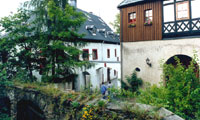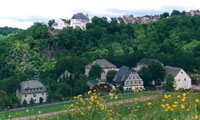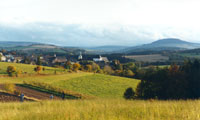| The historical Wolkenstein | |
|
| Wolkenstein today | |
|
| Wolkenstein City | |
 The city walls which are over 900 metres long, still circumvent to a certain extent the old city centre. Through the Mühltor, one of formerly three city gates, the visitor comes to the castle square. The city walls which are over 900 metres long, still circumvent to a certain extent the old city centre. Through the Mühltor, one of formerly three city gates, the visitor comes to the castle square.
There the venerable St. Bartholomaeus Church stands next to the castle. The church was comprehensively renovated in the 1980s. Inside the church an altar from 1648, the Steinmüller organ and precious brass lamps from the 19th century can be found. The close connection to the mediaeval castle authority is seen in the sandstone relief of St. George, to whom the church was originally dedicated, and knight's crest. A restored post marker from 1730 can be admired on the market place which was newly designed in 2001. The distances given on it are in hours, something which may confound the onlooker, until he reads that a hour is an old measurement which equalled approximately 4.5 kilometres. The town hall, built in 1929, now stands on the exact spot its mediaeval predecessor once stood. In the advent season a large Christmas pyramid covered in carved figurines turns in the middle of the market place.
|
| Wolkenstein Castle |
 After 1500 the mediaeval castle was turned into a residence for Duke Henry II of Saxony. In the 19th century further renovation took place as a royal county court resided in the buildings. For over 40 years there has been a museum of city history in the Late Gothic buildings with the permanent exhibit 'Land of the Amethyst'. In the former dungeon there is a private collection of the history of mediaeval jurisdiction.
Since July 2002 wedding ceremonies have been held in the former guard house. The historic public house 'Zum Grenadier' sends its guests back to the Napoleonic Era. The city library is located one storey up. Every year on Ascension Day, the castle is the focus of a four-day long castle festival with mediaeval market, knight jousting and music. |
| surrounding area | |
 More than 50 km of hiking trails, a mining nature trail and a bike trail along a former train embankment lead the visitor into the charming landscape around Wolkenstein. The 'Wolkenstein Switzerland' a rocky region with 80 m high rock faces, the Heidelbach valley with it old chalk mine, view points like the Ziegenfelsen, the Zeisigstein or the Anton Günther Heights offer year-round peace and relaxation. More than 50 km of hiking trails, a mining nature trail and a bike trail along a former train embankment lead the visitor into the charming landscape around Wolkenstein. The 'Wolkenstein Switzerland' a rocky region with 80 m high rock faces, the Heidelbach valley with it old chalk mine, view points like the Ziegenfelsen, the Zeisigstein or the Anton Günther Heights offer year-round peace and relaxation. For those who are active, the cliffs below the castle, the hedge with the wolf's ravine offer climbing possibilities and you can canoe along the Zschopau River. Warmbad which belongs to Wolkenstein, is connected to the Wiesenbad hot springs by a spa trail. In the neighbouring villages, typical Erz Mountain 'Waldhufen'-style villages with long strips of land lined up along a single road, half timbered houses, old village churches, bed and breakfasts and hotels can be discovered. At the Wolkenstein train station you can eat and sleep in the unique train hotel 'Einsteigen bitte!'. | |